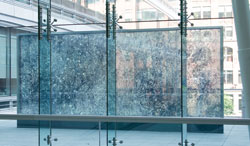Public art means opportunity and space

Geneviève Cadieux produced June by researching a winter-proof photo reproduction technique.
Richard-Max tremblay - courtesy of the Galerie René Blouin
It used to be that artists could find a patron to support and promote their work. However, it’s a rare sculptor who can find someone with the means and space to buy and display multiple pieces.
Public programs like the one run by provincial government’s Service de l’intégration des arts à l’architecture et à l’environnement (known as the one per cent program) have filled that role. This program allocates a fraction of the funds devoted to the construction or major renovation of any public building to an artist to create work specific to the project.
According to David Elliot, chair of the Studio Arts Department, these are incredible opportunities for faculty: “All of our faculty are practicing artists.” He can reel off the names of numerous professors who have benefited from this, and similar programs. Our EV Building features the work of Nicolas Baier on the East facade through the 1 per cent program.
A committee is struck for each new construction including an architect, art expert , program representatives and a building user. They determine the overall budget and where they would like art displayed. They then select three from a bank of potential artists and invite them to present models.
“The proposal has to include everything — materials, budget, content and techniques,” said photographer Raymonde April, who has received two such commissions, both for health centres. “Once you’ve done the model, you’ve basically done the piece itself.”
Planning the piece and its connection to the building and environment is critical; otherwise, the artist can find himself or herself out of pocket for the research and time spent on the proposal.
April said that one of her commissions was to produce 72 images to be used throughout a long-term care facility. “The project was really freeing and stimulating, and allowed me to rethink my work.”
Her pieces are displayed inside buildings. Geneviève Cadieux, also a photographer, has had work commissioned for outdoors.
“Photography is essentially ephemeral. To exhibit it outside involves an interesting set of challenges,” said Cadieux, a Studio Arts professor.
Most recently, she produced an image for outdoor display on the terrace of the Centre CDP Capital à Montreal. She learned of a German firm that prints on glass, and then fires the image to preserve it.
“It is not easy to find a company willing to work with an artist. The expectations around print quality and production are different than for industry.” When she was commissioned to produce the photograph she has sitting on top of the Montreal Museum of Contemporary Art in the early ’90s, she opted for a then little-known process called ink jet printing. “We had to have it done in Ontario.”
Weather and technical support are not the only things artists have to contend with. The permanence of the piece also dictates its content, as does its context.
“You’re really putting something out there. It’s not the same public as a gallery or museum, it’s a public public,” said Andrew Dutkewych. “You have to think about designing something for a long time. Studio or gallery work can be much more immediate or experimental.”
One of his pieces sits outside the Pointe à Callière museum in Old Montreal. Currently, he is working on a six-metre-tall bronze tree for an outdoor courtyard as part of the expansion of the Centre Hospitalier Université de Sherbrooke. “The scale is very different than it is for a gallery.”